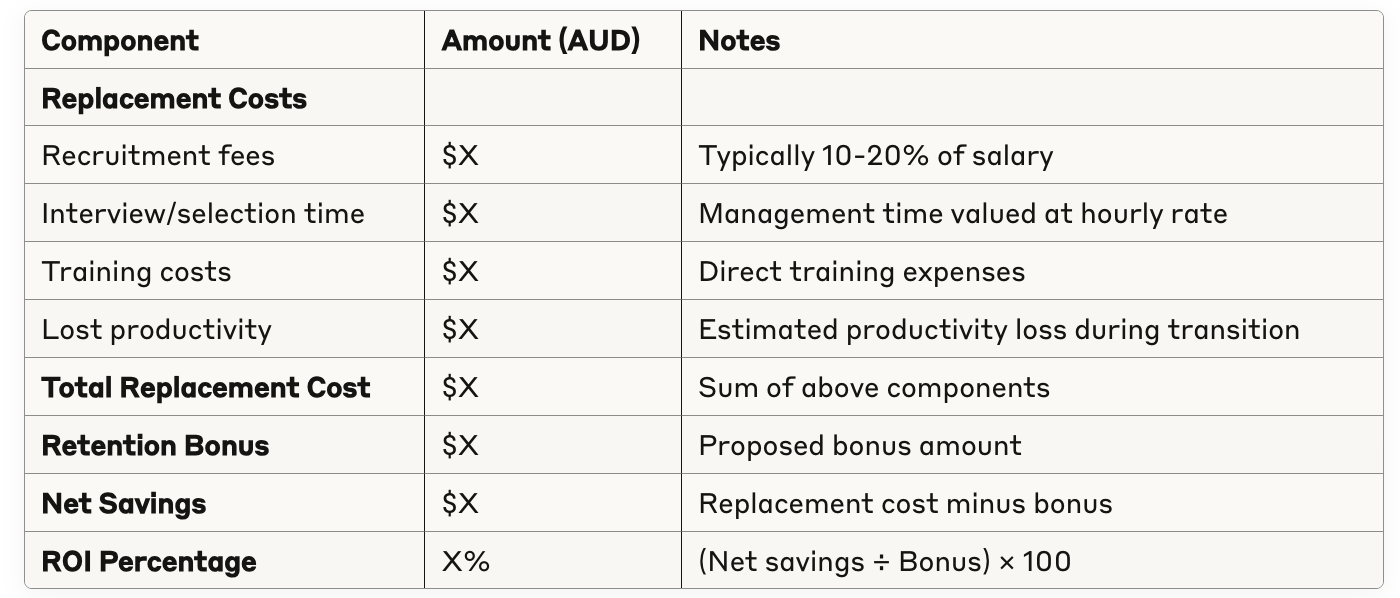
Published: July 2025
Employee turnover is costing Australian small and medium enterprises (SMEs) more than ever. With the Australian Bureau of Statistics reporting that voluntary turnover rates reached 8.9% in 2024, and the cost of replacing a skilled employee averaging between $15,000 to $25,000, retention bonuses have become a critical tool for savvy business owners.
Employee retention bonuses are lump-sum payments designed to incentivise valuable employees to stay with your company for a specified period. Unlike performance bonuses, these payments are specifically tied to tenure and commitment rather than output or results.
When an employee leaves, the true cost extends far beyond their final pay packet. Consider these factors:
Direct Costs:
Indirect Costs:
For a mid-level employee earning $70,000 annually, total replacement costs typically range from $21,000 to $35,000 – making retention bonuses an attractive alternative investment.
The Australian employment landscape has shifted dramatically. Skills shortages across industries, particularly in technology, healthcare, and skilled trades, have given employees unprecedented leverage. The Reserve Bank of Australia's 2024 labour market report indicates that job mobility has increased by 23% compared to pre-pandemic levels.
Immediate payments contingent on remaining with the company for a predetermined period, typically 12-24 months.
Example: A marketing manager receives a $5,000 stay bonus, payable immediately, with the agreement to remain employed for 18 months. If they leave before this period, they must repay the bonus.
Payments distributed over time, reducing the financial risk if an employee leaves early.
Example: A $12,000 retention bonus paid quarterly over two years ($1,500 per quarter), with no repayment required for amounts already received.
Payments tied to completing specific projects or reaching company milestones.
Example: An IT specialist receives a $8,000 bonus upon successful completion of a software implementation project, regardless of timeline.
Regular payments celebrating employment anniversaries or achieving service milestones.
Example: Annual retention bonuses of $2,000 for employees reaching their 3rd, 5th, and 10th anniversaries.
Most retention bonuses are classified as salary or wages and are therefore exempt from FBT. However, businesses must ensure proper documentation and compliance with Australian Taxation Office (ATO) requirements.
Key Points:
Retention bonuses are typically tax-deductible business expenses when:
ROI = (Cost of Replacement - Cost of Retention Bonus) ÷ Cost of Retention Bonus × 100
Scenario: A Sydney-based accounting firm wants to retain a senior accountant earning $85,000 annually.
Replacement Costs:
Retention Bonus: $7,500
ROI Calculation:
ROI = ($21,500 - $7,500) ÷ $7,500 × 100 = 187%
This represents a 187% return on investment, making the retention bonus highly cost-effective.
Focus retention efforts on employees who:
Optimal Timing:
Best Practices:
Retention bonuses must comply with Australian employment law, including:
Retention Bonus Agreement Should Include:
"If the employee voluntarily terminates employment or is dismissed for serious misconduct within 24 months of receiving this bonus, the full amount must be repaid within 30 days of employment termination."
With Australia's tech talent shortage, retention bonuses ranging from $10,000-$25,000 are common for skilled developers and engineers.
Nursing and allied health professionals often receive retention bonuses of $3,000-$8,000, particularly in regional areas.
Project-based retention bonuses averaging $5,000-$15,000 help maintain skilled tradespeople through project completion.
While retention bonuses are effective, consider complementary approaches:
Track these metrics to evaluate retention bonus effectiveness:
Quarterly reviews should assess:
Failing to properly document retention bonus agreements can lead to disputes and legal complications.
Not accounting for PAYG withholding, superannuation, and potential payroll tax can create compliance issues.
Different roles and employees require tailored retention strategies rather than blanket bonus amounts.
Unclear terms or expectations can damage employee relationships and trust.
Failing to maintain engagement beyond the bonus period often results in delayed departures.
With inflation and cost of living pressures, retention bonuses are likely to increase in value and frequency across Australian SMEs.
Employee retention bonuses represent a strategic investment in your company's most valuable asset – your people. For Australian SMEs facing competitive talent markets and rising replacement costs, well-designed retention programs offer substantial returns on investment.
The key to success lies in understanding your specific business needs, properly structuring bonus programs, ensuring legal compliance, and maintaining open communication with your team. When implemented thoughtfully, retention bonuses can significantly reduce turnover costs while building stronger, more committed teams.
Remember that retention bonuses are most effective when combined with broader employee engagement initiatives, competitive compensation packages, and positive workplace cultures. By taking a holistic approach to employee retention, Australian SMEs can build resilient, loyal teams that drive long-term business success.


Q: What are employee retention bonuses?
Employee retention bonuses are lump-sum payments designed to incentivise valuable employees to stay with a company for a specified period, tied to tenure and commitment rather than performance or results.
Q: What is the current voluntary turnover rate in Australia?
The Australian Bureau of Statistics reports that voluntary turnover rates reached 8.9% in 2024, with replacement costs for skilled employees averaging $15,000 to $25,000.
Q: What are the direct and indirect costs of employee turnover?
Direct costs include recruitment fees, interview time, training, and temporary staffing. Indirect costs include lost productivity, reduced morale, knowledge drain, and client relationship disruption. For a $70,000 employee, total costs range from $21,000 to $35,000.
Q: What market conditions are affecting employee retention in Australia?
Skills shortages in technology, healthcare, and trades give employees leverage, with job mobility up 23% from pre-pandemic levels per the Reserve Bank of Australia's 2024 report.
Q: What are the types of employee retention bonuses?
Stay bonuses (immediate payment with repayment if leaving early), vesting schedules (distributed over time), project completion bonuses (tied to milestones), and anniversary bonuses (for service milestones).
Q: What are the tax implications of retention bonuses for Australian employers?
Bonuses are classified as salary or wages, exempt from FBT, but require PAYG withholding, superannuation contributions (11.5%), and may incur payroll tax. They are tax-deductible if related to services and income-producing activities.
Q: What are the tax implications for employees?
Retention bonuses are taxable income, subject to PAYG withholding at standard rates.
Q: How do you calculate ROI for retention bonuses?
ROI = (Cost of Replacement - Cost of Retention Bonus) ÷ Cost of Retention Bonus × 100. For example, with $21,500 replacement cost and $7,500 bonus, ROI = ($21,500 - $7,500) ÷ $7,500 × 100 = 187%.
Q: How should SMEs identify employees for retention bonuses?
Focus on those with critical knowledge, high market demand, high replacement costs, or declining engagement.
Q: What is the optimal timing for offering retention bonuses?
Before annual reviews, during peak recruitment seasons, after company changes, or when competitors recruit.
Q: What communication strategies work for retention bonuses?
Present as investment in value, communicate terms clearly, provide written agreements, and emphasise career development.
Q: What legal considerations apply to retention bonuses in Australia?
Comply with Fair Work Act 2009, awards, enterprise agreements, state legislation, and anti-discrimination laws. Include payment details, period requirements, repayment clauses, and termination scenarios in agreements.
Q: What are industry-specific retention bonus examples?
Technology: $10,000-$25,000 for developers. Healthcare: $3,000-$8,000 for nurses in regional areas. Construction: $5,000-$15,000 for project completion.
Q: What are alternative retention strategies?
Non-monetary incentives like flexible work, development opportunities, additional leave; total rewards like enhanced super, wellness programs, share schemes, and recognition.
Q: How do you measure retention bonus success?
Track turnover rates, time to fill positions, satisfaction scores, cost per hire reduction, revenue per employee. Review quarterly with market benchmarks and feedback.
Q: What common mistakes should be avoided with retention bonuses?
Inadequate documentation, ignoring tax implications, one-size-fits-all approaches, poor communication, and neglecting follow-up engagement.
Q: What are future trends in employee retention?
Increased work-life balance incentives, technology-enabled tracking, personalised packages, integration with employee experience, and higher bonuses due to inflation and cost of living pressures.
If you require assistance with employee retention bonuses for your Australian business, Scale Suite provides services including bookkeeping, tax compliance, and financial reporting. These can assist with tasks such as bonus calculations, payroll processing, tax implications analysis, superannuation management, and ROI assessments. For more details, visit www.scalesuite.com.au/services/finance.
We review and check articles on a periodic basis, and at the time of writing this information was up to date from our assessment.
Scale Suite delivers embedded finance and human resource services for ambitious Australian businesses.Our Sydney-based team integrates with your daily operations through a shared platform, working like part of your internal staff but with senior-level expertise. From complete bookkeeping to strategic CFO insights, we deliver better outcomes than a single hire - without the recruitment risk, training time, or full-time salary commitment.
Considering hiring finance staff? Let's compare what you'd get with an internal hire versus our embedded team approach.
Our experts will show you the complete picture - costs, capabilities, and flexibility - so you can make the right decision for your business.
No lock-in contracts and 30 day money back guarantee.



